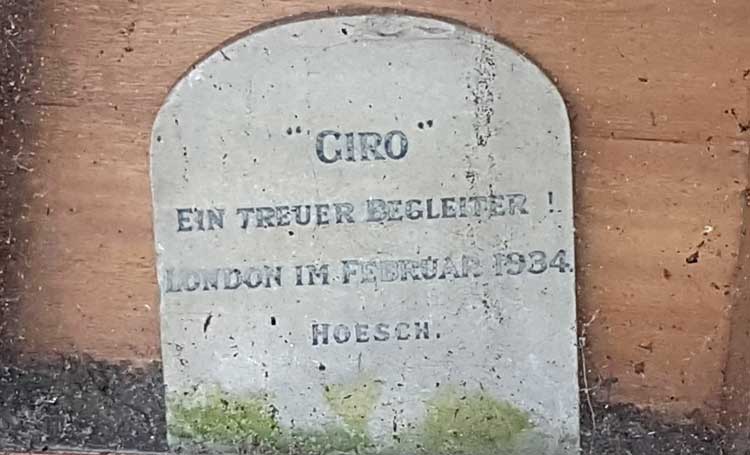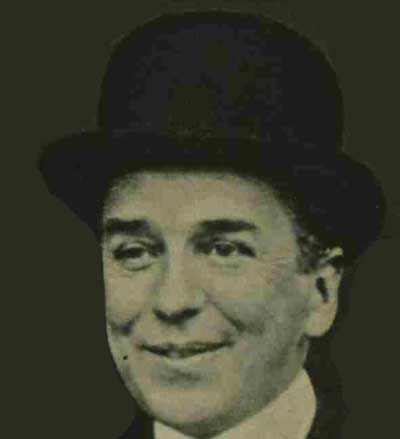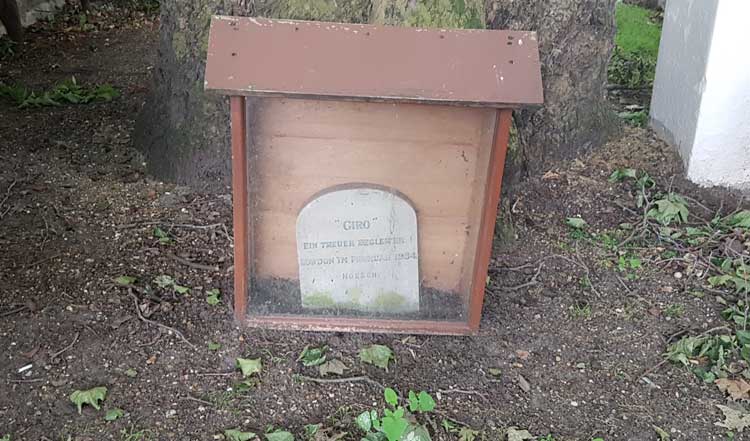
Tucked away behind the railings at the top of Duke of York Steps, alongside number 9, Carlton House Terrace, there stands a tiny tombstone on which can be read the inscription, "Giro" Ein Truer Begleiter! London Im Februar 1934. Hoesch. This translates as, "Giro "A faithful companion! London in February 1934. Hoesch.
The memorial remembers a German Ambassador's dog, and it is here because the building that stands to the right of the soaring tree that overshadows the tiny stone, 9, Carlton House Terrace, was the German Embassy until September, 1939.
In consequence, the Giro memorial is often described, unfairly as it happens, as the only Nazi monument in London.
The German Ambassador in question was Leopold von Hoesch (1881 - 1936), who arrived in London on Wednesday, 2nd November, 1932 to represent the Weimar Republic in Britain.

Leopold von Hoesch in 1932.
He had formerly been the German Ambassador to Paris, and, upon his arrival in London, the British newspapers were fulsome in their praise of his diplomatic talents.
In addition to being an extremely able diplomat, he was also, according to The Scotsman, "Socially extremely popular." The newspaper went on to to explain to its readers that, "Herr von Hoesch is a bachelor, and, at all official banquets and receptions at the Paris Embassy, always did the honours himself unaided by any female relative or the wife of any of his secretaries..."
His diplomatic skills would be severely tested when, within a few months of his arrival, the Third Reich came to power in Germany, in January, 1933, and Herr von Hoesch found himself serving new and very different masters.
However, he rose to the challenge and became well-liked and admired by the majority of British politicians, who viewed him as a knowledgeable and able-minded statesman.
Over the next three years, he worked tirelessly to enhance Anglo-German relations.
When he took up residence at 9, Carlton House Terrace, in November, 1932, he brought with him to the Embassy his pet dog, Giro, a German Shepherd - or at least that's what the majority of accounts say the dog's breed was.
The truth is, nobody actually knows that much about Giro.
The only certainty is that he died in February 1934, and that is only certain because it is etched onto his gravestone.
As to how he died? Well, again, we don't really know; we just know that he must have died, because if he wasn't dead and they buried him in the Embassy garden, well, that's too cruel to contemplate!
Tradition maintains that the poor pooch was electrocuted when he chewed through an electric cable at the Embassy, but there is no actual proof of this being the case.
So let's just say that Giro died in February 1934, and Herr von Hoesch had him buried in the Embassy garden and commissioned the tiny tombstone on which he had carved the rather poignant inscription, "Ein Truer Begleiter."
Two years later, on Friday, 10th April, 1936, at a little after 10am, von Hoesch was dressing after having had a bath in an apartment at the German Embassy, when he suffered a heart attack from which he died before medical aid could be summoned.
According to an Embassy official, who was quoted in the newspapers, his death was "so unexpected as to completely stun us all...Herr von Hoesch was thought to be in excellent health..."
His death was generally attributed to the strain he had been under in trying to preserve Anglo-German relations, and it is perhaps no co-incidence that, shortly before his death, Joachim von Ribbentrop, Hitler's "Ambassador-at-Large", had paid a visit to London to represent Germany before the Council of the League of Nations.
In the aftermath of his demise, newspapers and politicians remembered him fondly.
The Leeds Mercury, on Saturday, 11th April 1936, praised his sartorial elegance:-
"At all diplomatic gatherings Herr von Hoesch's lithe figure was familiar. He was always like a Prussian Guards officer in his dignified bearing. He acquired, as a result of his faultless tailoring, the reputation of being the man with the most suits in London. He was reputed to possess over 100 suits. These were kept in two rooms at the Embassy, and in 1933 it was stated that it required two days to unpack these suits. He had a pair of shoes to tone with each suit and a remarkable assortment of hats, levee wear, riding clothes and morning suits. He entertained lavishly and was the friend of many British statesmen."
According to Winston Churchill:- "He possessed great skill and distinction in diplomacy, He has been taken from us when he was most especially needed."
Ramsay McDonald remembered him as "...one of the most distinguished of the old school diplomats - a man who did his work quietly and efficiently and with that invaluable characteristic in international negotiations understanding the people with whom he was dealing."
On Wednesday, 15th April, 1936, his cortege set off from the German Embassy for Victoria Station, from where his body was taken to Dover to be returned to Germany for burial.
The Daily Herald published the following account of the procession in its next day's edition:-
"Full military honours were paid in London and Dover.
A large red flag, bearing the black swastika in the centre, covered the coffin, which was carried by six Grenadier Guards from the German Embassy to a gun-carriage. German officers in field-grey uniform and steel helmets walked beside it.
Ministers and diplomats of many nations, in full-dress uniform, walked behind the gun-carriage through the streets to Victoria Station.
Mr. Eden, Sir John Simon and Lord Monsell, First Lord of the Admiralty, were foremost in the procession.
A troop of Royal Horse Guards and two companies of Grenadier Guards led the procession. Funeral music was played by the Grenadiers band.
Coldstream Guards presented arms on the arrival of the coffin at Victoria Station, and four members of the German Embassy staff, all in evening dress, stood at the Nazi salute.
The German national anthem rang through the station before the train's departure."
An eerie piece of newsreel footage of the cortege has survived, and it seems decidedly odd seeing the Nazi salutes over the swastika-draped coffin whilst stiff-necked British officials look on.
The Portsmouth Evening News, on Wednesday, 15th April 1936, carried the following brief article, which shows that a new dog had taken Giro's place in the ambassadors affections:-
"Two sisters of the Ambassador are accompanying the body back to Germany, and with them will go Martin, a Bedlington terrier, to which Herr von Hoesch was deeply attached. The dog was a present from an English friend."
With the outbreak of the Second World War, the German Embassy was closed, and, after the war, the building was handed over to the Foreign Office, until, in 1967, the current occupants, the Royal Society, moved in.
In 1966, an underground car park had been excavated on the strip of land between 9, Carlton Terrace and the Duke of York's steps.
It appears that Giro's tombstone was re-discovered, or at least noticed, during this building work, and it was moved to a new position in front of the tree, where it can now be seen by any passer-by who takes the trouble to peer through the gates in front of it.

At some stage, it acquired the perspex fronted kennel that now protects the stone from the elements, and it stands as a fitting tribute to a beloved canine who nobody seems to have remembered, and about whom very little is known, other than that Giro was emphatically no Nazi.